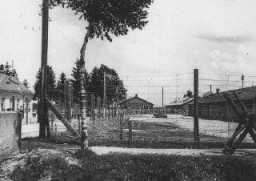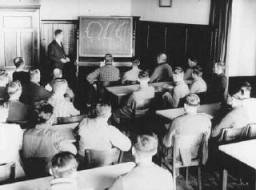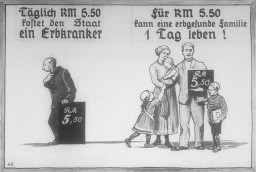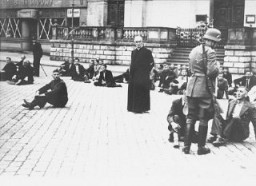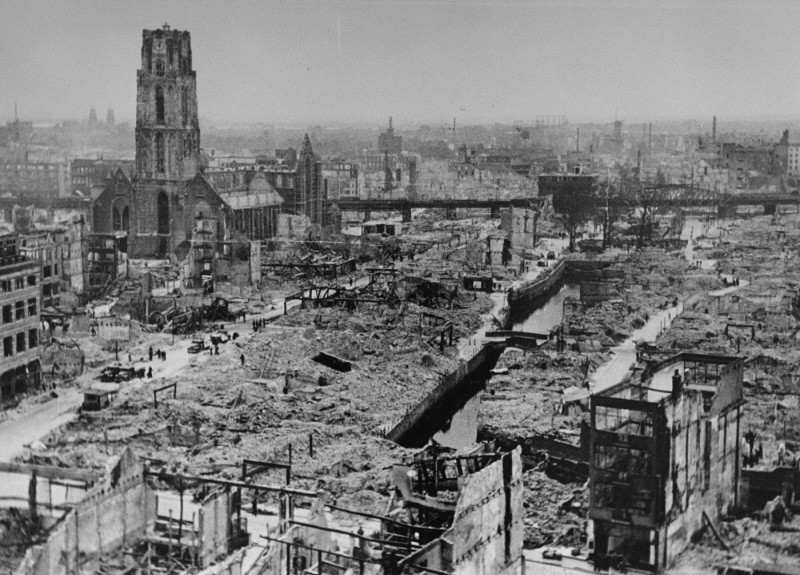
World War II in Europe
Germany rapidly conquered much of Europe and the Soviet Union from 1939 to 1942. Soviet victories over German forces reversed the course of the war in 1942–43. With the Allies advancing from both the east and west, Germany surrendered in 1945.
World War II in Europe During World War II, Germany overran much of Europe using a new tactic called the "Blitzkrieg" (lightning war). Blitzkrieg involved the massing of planes, tanks, and artillery. These forces would break through enemy defenses along a narrow front. Air power prevented the enemy from closing the breach. German forces encircled opposing troops, forcing them to surrender.
Using the Blitzkrieg tactic, Germany defeated Poland (attacked in September 1939), Denmark (April 1940), Norway (April 1940), Belgium (May 1940), the Netherlands (May 1940), Luxembourg (May 1940), France (May 1940), Yugoslavia (April 1941), and Greece (April 1941). Yet Germany did not defeat Great Britain, which was protected from ground attack by the English Channel.
German forces attacked the Soviet Union in June 1941, pushing more than 600 miles to the gates of Moscow. A second German offensive in 1942 brought German soldiers to the shores of the Volga River and the city of Stalingrad. But the Soviet Union, together with Great Britain and the United States, which had entered the war against Germany in December 1941, turned the tide of battle against Germany.
In the east, the battle for Stalingrad proved a decisive turning point. After the defeat at Stalingrad in winter of 1942–43, German troops began the long retreat. In April 1945 Soviet forces entered Berlin. In the west, Allied soldiers landed on June 6, 1944 (known as D-Day) in Normandy, France. More than two million Allied soldiers poured into France. In July, Allied forces broke out of the Normandy beachhead. The Allies continued the attack into Germany. In March 1945, Allied forces crossed the Rhine, advancing into the heart of Germany.
Nazi Germany surrendered in May 1945.
Key Dates
September 1, 1939
German forces invade Poland
German units, with more than 2,000 tanks and 1,000 planes, break through Polish defenses along the border and advance on Warsaw in a massive encirclement. Britain and France, standing by their guarantee of Poland's border, declare war on Germany on September 3, 1939. Warsaw surrenders to the Germans on September 28, 1939. The Polish army is defeated within weeks of the German invasion.
April 9, 1940
Germany conquers Norway and Denmark
In a lightning attack, German forces attack Norway and Denmark. Denmark is occupied in one day. German forces land in Norway near Oslo, the capital, and in other places, securing the south. Germany also moves to secure the ports of Narvik and Trondheim in the north. British forces intervene, landing at Narvik, Namsos, and Andalsnes, but will be forced to withdraw by the first week of June 1940. Norway surrenders to Germany on June 10.
May 10, 1940
German forces invade western Europe
The campaign against the Low Countries and France lasts less than six weeks. The Germans concentrate their attack through Luxembourg and the Ardennes Forest near the French city of Sedan. German tanks and infantry burst through the French defensive lines and advance to the coast, trapping the British and French armies in the north. The Allies successfully evacuate over 300,000 troops from Dunkerque (Dunkirk) to Britain, but France is decisively defeated. Paris, the French capital, will fall to the Germans on June 14, 1940. As part of the armistice agreement France signs with Germany on June 22, Germany occupies northern France while southern France remains unoccupied. A new French government (situated in Vichy) declares neutrality in the war, but promises cooperation with Germany.
1941
German forces invade Yugoslavia and Greece
German forces invade Yugoslavia and Greece, supported by contingents from Germany's allies (Italy, Bulgaria, Hungary, and Romania), and quickly subdue the Balkans. British forces, sent to aid the Greeks, are forced to withdraw to the island of Crete. In mid-May, German paratroopers land on Crete and, after heavy fighting, defeat the British there. Yugoslavia and Greece are partitioned among the victors.
June 22, 1941
German forces attack the Soviet Union
More than three million German soldiers, reinforced by half a million auxiliaries from Germany's allies (Finnish, Romanian, Hungarian, Italian, Slovakian, and Croatian troops, and a contingent from Spain), attack the Soviet Union across a broad front, from the Baltic Sea in the north to the Black Sea in the south. Three German army groups advance deep into Soviet territory. Millions of Soviet soldiers are encircled and forced to surrender. German troops continue to advance to the outskirts of Moscow. In December 1941, the Soviet Union launches a counteroffensive, forcing a German retreat from Moscow.
June 28, 1942
German forces advance to the Volga River
German forces begin a new drive to the east. This time the goals are the oil fields of the Caucasus and the city of Stalingrad on the Volga River. By the beginning of July, German forces cross the Don River and by mid-September reach the suburbs of Stalingrad. The Soviet army command decides to defend the city, no matter what the cost. Soviet forces fight for every street in the city. By the middle of November 1942, the Germans gain control of most of the city, but the Soviet defense has not been broken. The Soviet army launches a counteroffensive against the German forces arrayed at Stalingrad in mid-November 1942. They quickly encircle an entire German army, some 250,000 soldiers.
February 2, 1943
German 6th Army surrenders at Stalingrad
The Soviet army launched a counteroffensive against the German forces arrayed at Stalingrad in mid-November 1942. They quickly encircled an entire German army, some 250,000 soldiers. After months of fierce fighting and heavy casualties, the surviving German forces, now only about 91,000 soldiers, surrender. Soviet forces push the Germans back to the banks of the Dnieper River in 1943. The Soviet army remains on the offensive for the remainder of the war, despite some temporary setbacks.
June 6, 1944 (D-Day)
Allied forces land in France
More than 150,000 Allied soldiers under the command of US General Dwight D. Eisenhower land on the beaches of Normandy, France. The Allies break out of the Normandy beachheads, and will enter Paris on August 25, 1944. They liberate most of France by the end of August. The western Allies are surprised in December 1944 when German forces attack through the Ardennes Forest in Belgium in an attempt to divide and destroy Allied forces. Allied air forces, together with a fierce American defense, block the advance of German troops and force them into a general retreat. The Allies win a decisive victory in what becomes known as the Battle of the Bulge, and continue the attack into Germany itself.
June 22, 1944
Soviet forces launch crushing offensive
Soviet forces launch a powerful offensive along the entire eastern front. German forces are pushed back nearly to Warsaw by the end of July 1944. In August and September 1944, Germany's remaining eastern European allies (Romania, Bulgaria, Finland) leave the war effort. Hungary, occupied by Germany in March, remains in the German camp.
May 7, 1945
German forces surrender
In mid-April 1945, Soviet forces launched a massive offensive toward Berlin. On April 25, 1945, Soviet forces linked up with American forces attacking from the west at Torgau, on the Elbe River, in central Germany. As Soviet forces neared his command bunker in central Berlin on April 30, 1945, Adolf Hitler committed suicide. Berlin surrendered to Soviet forces on May 2, 1945. The German armed forces surrender unconditionally in the west on May 7 and in the east on May 9, 1945. Victory in Europe Day (V-E Day) is proclaimed for May 8, 1945.



